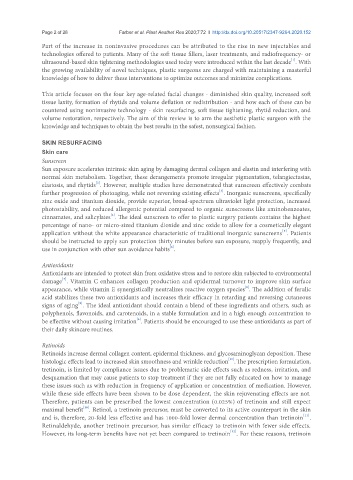Page 852 - Read Online
P. 852
Page 2 of 28 Farber et al. Plast Aesthet Res 2020;7:72 I http://dx.doi.org/10.20517/2347-9264.2020.152
Part of the increase in noninvasive procedures can be attributed to the rise in new injectables and
technologies offered to patients. Many of the soft tissue fillers, laser treatments, and radiofrequency- or
[1]
ultrasound-based skin tightening methodologies used today were introduced within the last decade . With
the growing availability of novel techniques, plastic surgeons are charged with maintaining a masterful
knowledge of how to deliver these interventions to optimize outcomes and minimize complications.
This article focuses on the four key age-related facial changes - diminished skin quality, increased soft
tissue laxity, formation of rhytids and volume deflation or redistribution - and how each of these can be
countered using noninvasive technology - skin resurfacing, soft tissue tightening, rhytid reduction, and
volume restoration, respectively. The aim of this review is to arm the aesthetic plastic surgeon with the
knowledge and techniques to obtain the best results in the safest, nonsurgical fashion.
SKIN RESURFACING
Skin care
Sunscreen
Sun exposure accelerates intrinsic skin aging by damaging dermal collagen and elastin and interfering with
normal skin metabolism. Together, these derangements promote irregular pigmentation, telangiectasias,
[2]
elastosis, and rhytids . However, multiple studies have demonstrated that sunscreen effectively combats
[3]
further progression of photoaging, while not reversing existing effects . Inorganic sunscreens, specifically
zinc oxide and titanium dioxide, provide superior, broad-spectrum ultraviolet light protection, increased
photostability, and reduced allergenic potential compared to organic sunscreens like aminobenzoates,
[4]
cinnamates, and salicylates . The ideal sunscreen to offer to plastic surgery patients contains the highest
percentage of nano- or micro-sized titanium dioxide and zinc oxide to allow for a cosmetically elegant
[5]
application without the white appearance characteristic of traditional inorganic sunscreens . Patients
should be instructed to apply sun protection thirty minutes before sun exposure, reapply frequently, and
[6]
use in conjunction with other sun avoidance habits .
Antioxidants
Antioxidants are intended to protect skin from oxidative stress and to restore skin subjected to environmental
[7]
damage . Vitamin C enhances collagen production and epidermal turnover to improve skin surface
appearance, while vitamin E synergistically neutralizes reactive oxygen species . The addition of ferulic
[8]
acid stabilizes these two antioxidants and increases their efficacy in retarding and reversing cutaneous
signs of aging . The ideal antioxidant should contain a blend of these ingredients and others, such as
[9]
polyphenols, flavonoids, and carotenoids, in a stable formulation and in a high enough concentration to
be effective without causing irritation . Patients should be encouraged to use these antioxidants as part of
[4]
their daily skincare routines.
Retinoids
Retinoids increase dermal collagen content, epidermal thickness, and glycosaminoglycan deposition. These
[10]
histologic effects lead to increased skin smoothness and wrinkle reduction .The prescription formulation,
tretinoin, is limited by compliance issues due to problematic side effects such as redness, irritation, and
desquamation that may cause patients to stop treatment if they are not fully educated on how to manage
these issues such as with reduction in frequency of application or concentration of medication. However,
while these side effects have been shown to be dose dependent, the skin rejuvenating effects are not.
Therefore, patients can be prescribed the lowest concentration (0.025%) of tretinoin and still expect
[10]
maximal benefit . Retinol, a tretinoin precursor, must be converted to its active counterpart in the skin
and is, therefore, 20-fold less effective and has 1000-fold lower dermal concentration than tretinoin .
[11]
Retinaldehyde, another tretinoin precursor, has similar efficacy to tretinoin with fewer side effects.
However, its long-term benefits have not yet been compared to tretinoin . For these reasons, tretinoin
[12]

